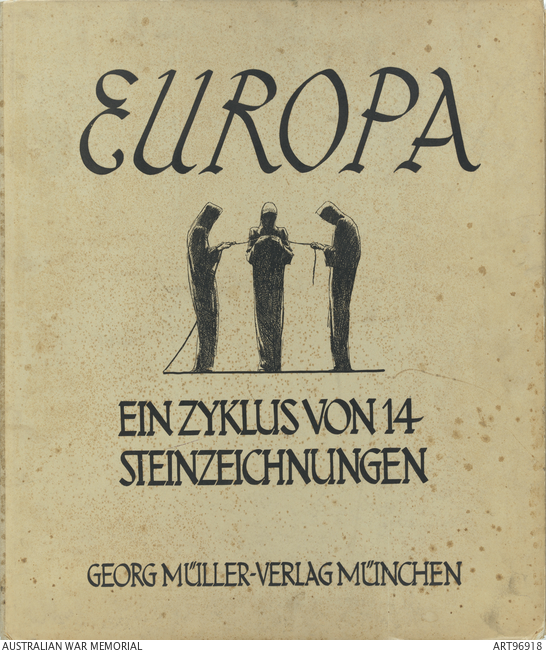| Accession Number | ART96918 |
|---|---|
| Collection type | Art |
| Measurement | Overall: 55 x 46.4 cm |
| Object type | |
| Physical description | Relief-etching printed in black ink from one block letterpress printed in black ink from one block on card |
| Maker |
Scharf, Theo Muller, Georg |
| Place made | Germany: Munich |
| Date made | 1922 |
| Conflict |
First World War, 1914-1918 |
| Copyright |
Item copyright: AWM Licensed copyright |
Europa [Portfolio of 14 lithographs]

The published print portfolio, 'Europa' was commissioned in 1922 by the publishing house, Georg Muller Verlad, and was one of the artist's first commissions for an illustrated book. Alongside the scharf's fourteen lithographs the portfolio contained an introductory text by the esteemed author Baron Frits von Ostini as context for the illustrations.
'Europa's' fourteen 'lithographic designs 'consist of Das schlafende Asien (Sleeping Asia), Tyrannei (Tyranny), Revolution, Napoleon, Industrialismus (Industrialism), Entgötterung (Turning from God), Demagogie (Demagogy), Japan, Kapitalismus (Capitalism), Krieg (War), Proletariat, Asiens Entflammung (Asia aflame), Zivilisation (Civilisation), Das Ende (The end).’ The portfolio was released in an edition of 300 and produced in the spring of 1922 at the Dr C Wolf & Sohn printing office in Munich for Georg Müller Verlag.
An artist with a commitment to the right wing national-conservative Deutschnationale Volkspartei (DNVP) or German National People’s Party, Scharf projects into his work his opposition of Treaty of Versailles and the Weimar Constitution. Scharf’s imagery is uncompromising and portentous as he lashed out against the madness and greed which had brought Europe close to collapse as a result of rapacious warmongering. Industrialism, with its pollution and exploitation of the proletariat, is featured in many of these images: soaring chimneys spewing smoke and ‘demonic steam’ and workers bent slavishly over their task at hand; civilisation is seen as an overcrowded metropolis, the seething mass of humanity is crowded into the factories and offices, pressing the heaving streets of the cities. It is an apocalyptic vision, denying the celebration of modernity espoused by the Futurist artists, and presaging the carnage and horrors of the war yet to come.